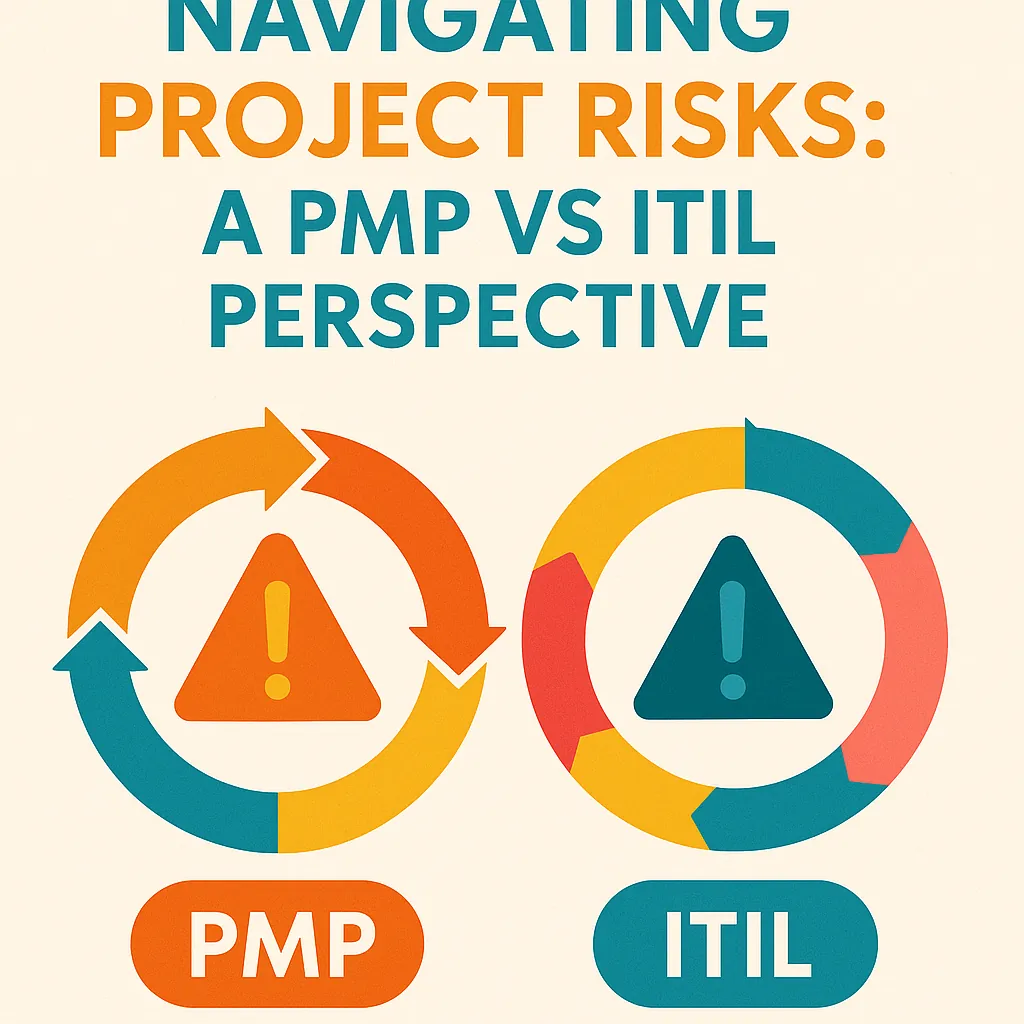Introduction
Effective risk management is paramount to ensuring that projects are completed on time and within budget. Two prominent frameworks that guide project managers in their endeavors are the Project Management Professional (PMP) certification and the Information Technology Infrastructure Library (ITIL). While both frameworks serve distinct purposes, they offer complementary approaches to managing risks within projects.
Defining PMP and ITIL
PMP, or Project Management Professional, is a globally recognized certification that emphasizes the principles and practices of project management. It focuses on the entire project lifecycle, from initiation to closure, and equips project managers with the skills necessary to identify, assess, and respond to risks effectively. PMP credential holders utilize various risk response strategies, including risk avoidance, mitigation, and escalation to ensure project success [1].
On the other hand, ITIL is a framework that provides best practices for IT service management. It emphasizes the alignment of IT services with the needs of the business and focuses on delivering value through effective service management. While ITIL is not solely focused on project management, it incorporates risk management principles that are essential for maintaining service quality and reliability [3][4].
The Importance of Risk Management in Project Management
Risk management is a critical component of project management, as it involves identifying potential risks that could impact project objectives and implementing strategies to mitigate those risks. Effective risk management not only helps in avoiding potential pitfalls but also enhances the likelihood of achieving project goals. By prioritizing risk management, project managers can ensure that they are prepared for uncertainties and can respond proactively to challenges that may arise during the project lifecycle [6][8].
Focus of the Blog: Comparing Risk Management Strategies within PMP and ITIL
This blog will delve into the risk management strategies employed within both the PMP and ITIL frameworks. By examining how each framework approaches risk identification, assessment, and response, we aim to provide valuable insights for risk managers and project managers alike. Understanding the strengths and limitations of each framework will enable professionals to navigate project risks more effectively and enhance their overall project management practices. Through this comparison, we will highlight the complementary nature of PMP and ITIL, showcasing how integrating both can lead to more robust risk management strategies in project execution [7][9].
Understanding Risk Management in PMP
The Project Management Professional (PMP) certification, governed by the Project Management Institute (PMI), provides a comprehensive framework for managing various aspects of projects, including risk management. The PMBOK (Project Management Body of Knowledge) Guide serves as the foundational document for PMP, outlining best practices, tools, and techniques essential for effective project management.
Overview of the PMBOK Guide and Its Structure
The PMBOK Guide is structured around five process groups: Initiating, Planning, Executing, Monitoring and Controlling, and Closing. Within these groups, it delineates ten knowledge areas, one of which is Risk Management. This structured approach ensures that risk management is integrated throughout the project lifecycle, allowing project managers to proactively identify and mitigate risks that could impact project objectives.
Detailed Explanation of the Risk Management Process in PMP
The risk management process in PMP is a systematic approach that consists of four key steps:
- Risk Identification: This initial step involves recognizing potential risks that could affect the project. Techniques such as brainstorming sessions, expert interviews, and checklists are commonly employed to uncover risks.
- Risk Analysis: Once risks are identified, they are analyzed to determine their potential impact and likelihood. This analysis can be qualitative, assessing the severity of risks based on their probability and impact, or quantitative, using numerical methods to evaluate the potential effect on project objectives.
- Risk Response Planning: After analyzing risks, project managers develop strategies to address them. This may involve avoiding, transferring, mitigating, or accepting risks. Each response is tailored to the specific risk and its context within the project.
- Risk Monitoring: The final step involves continuously tracking identified risks, monitoring residual risks, and identifying new risks throughout the project lifecycle. This ensures that risk management remains dynamic and responsive to changes.
Tools and Techniques Used in PMP for Risk Management
PMP employs various tools and techniques to facilitate effective risk management:
- Qualitative Analysis: This involves assessing risks based on their probability and impact, often using a risk matrix to prioritize risks.
- Quantitative Analysis: Techniques such as Monte Carlo simulations and decision tree analysis provide a numerical assessment of risks, helping project managers understand potential outcomes and their probabilities.
- Risk Registers: A risk register is a crucial document that captures all identified risks, their analysis, response strategies, and status updates. It serves as a living document that evolves throughout the project.
Examples of Risk Management Scenarios in PMP
To illustrate the application of risk management in PMP, consider the following scenarios:
- Scenario 1: A project team identifies a potential delay in the delivery of critical materials. Through qualitative analysis, they assess the likelihood of this risk as high and its impact as severe. The team decides to mitigate this risk by establishing alternative suppliers and adjusting the project schedule to accommodate potential delays.
- Scenario 2: During a software development project, a risk is identified regarding the integration of new technology. The team conducts a quantitative analysis, determining that the risk could lead to a 20% increase in project costs. They decide to transfer this risk by outsourcing the integration to a specialized vendor, thereby reducing their exposure.
By understanding and implementing these risk management strategies within the PMP framework, project managers can enhance their ability to navigate uncertainties and ensure successful project delivery. This structured approach not only minimizes potential disruptions but also fosters a culture of proactive risk management within organizations.
Understanding Risk Management in ITIL
ITIL (Information Technology Infrastructure Library) is a widely recognized framework that focuses on IT service management (ITSM) and aims to align IT services with the needs of the business. It provides a structured approach to managing IT services throughout their lifecycle, which includes stages such as service strategy, service design, service transition, service operation, and continual service improvement. This lifecycle framework is essential for understanding how risk management is integrated into ITIL processes.
Integration of Risk Management in ITIL Processes
Risk management is a critical component of ITIL, particularly within the service design and service transition phases. Here’s how it is integrated:
- Service Design: During this phase, risk management involves identifying potential risks associated with new or changed services. This includes assessing the impact of these risks on service quality and availability. The goal is to ensure that services are designed with risk mitigation strategies in place, which can include redundancy, failover mechanisms, and compliance with regulatory requirements.
- Service Transition: In this phase, risk management focuses on minimizing risks associated with deploying new or modified services into the live environment. This includes thorough testing, change management processes, and ensuring that all stakeholders are aware of potential risks and their mitigation strategies. Effective communication during this phase is crucial to ensure that all team members understand their roles in managing risks.
Key Components of ITIL Risk Management
ITIL outlines several key components that are essential for effective risk management:
- Risk Assessment: This involves identifying, analyzing, and evaluating risks to determine their potential impact on service delivery. ITIL emphasizes a proactive approach to risk assessment, encouraging organizations to regularly review and update their risk profiles.
- Risk Control: Once risks are identified, ITIL provides guidance on implementing controls to mitigate these risks. This can include technical controls, such as security measures, as well as procedural controls, such as change management processes that ensure risks are managed throughout the service lifecycle.
- Risk Communication: Effective communication is vital in risk management. ITIL stresses the importance of keeping all stakeholders informed about risks and the measures in place to manage them. This includes regular updates and training to ensure that everyone involved understands their responsibilities in risk management.
Examples of Risk Management Scenarios in ITIL
To illustrate the application of risk management within ITIL, consider the following scenarios:
- Scenario 1: Service Design Risk: An organization is designing a new cloud service. During the risk assessment phase, they identify potential risks related to data security and compliance with regulations. By implementing encryption and access controls, they mitigate these risks before the service is launched.
- Scenario 2: Service Transition Risk: A company is transitioning to a new ITSM tool. They conduct a thorough risk assessment and identify potential downtime during the transition. To mitigate this risk, they schedule the transition during off-peak hours and have a rollback plan in place should issues arise.
- Scenario 3: Continual Service Improvement: After a service outage, the organization conducts a post-incident review to assess what went wrong. They identify gaps in their risk management processes and implement changes to improve their risk assessment and control measures for future incidents.
Comparative Analysis of Risk Management Strategies
Both the Project Management Professional (PMP) and Information Technology Infrastructure Library (ITIL) frameworks offer valuable insights into risk management. While they share common objectives, their approaches and applications differ significantly. This section will explore these similarities and differences, providing a comprehensive understanding for risk managers and project managers.
Similarities in Risk Management Objectives
Both PMP and ITIL aim to enhance organizational effectiveness by managing risks that could impede project success or service delivery. Key objectives include:
- Risk Identification: Both frameworks emphasize the importance of identifying potential risks early in the process to mitigate their impact. This proactive stance is crucial for both project and service management environments [1][8].
- Risk Mitigation: PMP and ITIL advocate for developing strategies to mitigate identified risks. This includes planning and executing appropriate responses to minimize negative impacts on projects or services [1][12].
- Continuous Improvement: Both frameworks promote a culture of continuous improvement, encouraging organizations to learn from past experiences and refine their risk management processes over time [4][10].
Differences in Approach
While PMP and ITIL share similar objectives, their approaches to risk management diverge in several key areas:
- Proactive vs. Reactive Strategies: ITIL emphasizes proactive risk management, focusing on identifying and mitigating potential risks before they escalate. This approach is designed to prevent issues from arising in the first place [8]. In contrast, PMP often adopts a more reactive stance, where risks are managed as they occur, although it also incorporates proactive elements during the planning phase [1][12].
- Focus Areas: PMP is primarily concerned with project-specific risks, such as scope changes, resource availability, and timeline constraints. ITIL, on the other hand, focuses on service management risks, including service delivery failures and compliance issues. This distinction highlights the different contexts in which each framework operates [2][9].
Contextual Effectiveness
The effectiveness of PMP and ITIL in managing risks largely depends on the context in which they are applied:
- Project-Based Context: PMP is particularly effective in environments where projects are the primary focus. It provides a structured approach to managing risks associated with project execution, ensuring that project managers can navigate uncertainties effectively [3][5].
- Service Management Context: ITIL shines in service-oriented environments, where ongoing service delivery and customer satisfaction are paramount. Its proactive risk management strategies help organizations maintain service quality and reliability [6][7].
Influence of Organizational Culture
The adoption of risk management strategies from either framework is significantly influenced by organizational culture:
- Support for Proactive Practices: Organizations that foster a culture of proactive risk management are more likely to benefit from ITIL’s emphasis on identifying and mitigating risks before they escalate. This cultural alignment can lead to improved service delivery and customer satisfaction [8][14].
- Acceptance of Reactive Strategies: Conversely, organizations with a more reactive culture may find PMP’s approach more suitable, as it aligns with their existing practices of addressing risks as they arise. However, this can lead to missed opportunities for improvement and increased vulnerability to unforeseen issues [15].
Case Studies: Real-world Applications
Both the Project Management Professional (PMP) framework and the Information Technology Infrastructure Library (ITIL) provide structured approaches to managing risks. By examining real-world applications of risk management strategies from organizations that have successfully implemented these frameworks, we can draw valuable lessons and best practices that can enhance the effectiveness of risk management in various projects.
PMP Risk Management Case Studies
- Gordie Howe International Bridge Project: This project exemplifies the necessity of robust risk management practices within the PMP framework. The project team identified potential risks early in the planning phase, including environmental concerns and stakeholder opposition. By employing a comprehensive risk assessment process, they were able to develop mitigation strategies that addressed these risks effectively, ensuring the project remained on schedule and within budget. The proactive approach to risk management facilitated successful stakeholder engagement and minimized disruptions during construction [3].
- ApexTech Solutions: ApexTech, a tech company founded in 2005, is recognized for its exemplary risk management practices. The organization implemented PMP methodologies to identify and assess risks associated with launching new software products. By conducting thorough risk analysis and developing contingency plans, ApexTech successfully navigated challenges such as market competition and technological changes. The lessons learned from their experience highlight the importance of continuous risk monitoring and stakeholder communication throughout the project lifecycle [5].
ITIL Risk Management Case Studies
- Vodafone: Vodafone’s implementation of ITIL practices has significantly improved its risk management capabilities. The organization adopted ITIL’s service management framework to identify risks related to service delivery and customer satisfaction. By utilizing ITIL’s risk assessment tools, Vodafone was able to prioritize risks and implement effective controls, resulting in enhanced service reliability and customer trust. This case illustrates the value of integrating risk management into service management processes to achieve operational excellence [10].
- University of Oxford: The University of Oxford applied ITIL principles to manage risks associated with its IT services. By conducting regular risk assessments and utilizing ITIL’s best practices for incident management, the university was able to minimize the impact of service disruptions on academic operations. The case study emphasizes the importance of aligning risk management strategies with organizational goals and the need for ongoing training and awareness among staff to foster a risk-aware culture [10].
Lessons Learned and Best Practices
- Proactive Risk Identification: Both PMP and ITIL frameworks emphasize the importance of identifying risks early in the project lifecycle. Organizations that adopt a proactive approach to risk management are better equipped to mitigate potential issues before they escalate.
- Stakeholder Engagement: Successful risk management requires effective communication and collaboration with stakeholders. Engaging stakeholders throughout the risk management process helps ensure that all perspectives are considered, leading to more comprehensive risk assessments and solutions.
- Continuous Monitoring and Adaptation: Risk management is not a one-time activity; it requires ongoing monitoring and adaptation. Organizations should regularly review and update their risk management strategies to reflect changes in the project environment and emerging risks.
- Integration with Organizational Processes: Integrating risk management practices into broader organizational processes, such as service management (ITIL) or project management (PMP), enhances the overall effectiveness of risk management efforts. This alignment ensures that risk considerations are embedded in decision-making at all levels.
By analyzing these case studies, risk managers and project managers can glean insights into effective risk management strategies and apply these lessons to their own projects, ultimately leading to improved project outcomes and organizational resilience.
Best Practices for Integrating PMP and ITIL Risk Management Strategies
Integrating risk management practices from both the Project Management Professional (PMP) framework and the Information Technology Infrastructure Library (ITIL) can significantly enhance an organization’s ability to manage risks effectively. Here are some actionable recommendations for project and risk managers:
Strategies for Integrating Risk Management Practices
- Align Objectives: Ensure that the risk management objectives of both PMP and ITIL are aligned with the overall business goals. This alignment helps in creating a unified approach to risk management that supports both project delivery and IT service management [5].
- Utilize Common Terminology: Establish a common language and terminology between the two frameworks. This can facilitate better communication among team members and stakeholders, ensuring that everyone understands the risk management processes being implemented [11].
- Leverage ITIL’s Focus on Service Management: ITIL emphasizes the importance of managing risks related to IT services. Project managers can incorporate ITIL’s service management practices into their risk assessments to identify potential risks that may impact service delivery [9].
- Implement Continuous Monitoring: Both frameworks advocate for continuous monitoring of risks. By regularly reviewing and updating risk management plans, organizations can adapt to changing circumstances and improve their response strategies [8].
Tips for Choosing the Right Approach
- Assess Project Complexity: For complex projects, a hybrid approach that combines PMP’s structured project management techniques with ITIL’s service-oriented focus may be most effective. This allows for comprehensive risk identification and mitigation strategies that address both project and service delivery risks [10].
- Consider Organizational Culture: The choice of approach should reflect the organization’s culture and existing processes. Organizations that are more service-oriented may benefit from integrating ITIL practices, while those focused on project delivery may lean towards PMP methodologies [11].
- Evaluate Resource Availability: Assess the resources available for risk management. If the organization has a strong IT service management team, leveraging ITIL practices may enhance risk management efforts. Conversely, if project management resources are more robust, focusing on PMP strategies may be more beneficial [5].
Importance of Training and Continuous Improvement
- Invest in Training: Providing training for both project and risk managers on the principles and practices of PMP and ITIL is crucial. This training ensures that team members are equipped with the necessary skills to implement integrated risk management strategies effectively [12].
- Encourage a Culture of Continuous Improvement: Organizations should foster a culture that encourages continuous improvement in risk management practices. Regularly reviewing and refining risk management processes based on lessons learned can lead to more effective risk mitigation strategies over time [8].
- Utilize Feedback Mechanisms: Implement feedback mechanisms to gather insights from team members and stakeholders about the effectiveness of risk management practices. This feedback can inform adjustments and improvements in both PMP and ITIL approaches [12].
By integrating the risk management strategies of PMP and ITIL, organizations can create a more robust framework for managing risks, ultimately leading to improved project outcomes and enhanced service delivery.
Conclusion
Effective risk management is a cornerstone of successful project management, as it directly influences the likelihood of achieving project objectives while minimizing potential setbacks. Both the Project Management Professional (PMP) framework and the Information Technology Infrastructure Library (ITIL) offer distinct yet complementary approaches to managing risks within projects.
- PMP Framework: This framework emphasizes a structured approach to risk management throughout the project life cycle. It focuses on identifying, analyzing, and responding to risks, ensuring that project managers can enhance the probability of positive outcomes while mitigating negative impacts. The PMP methodology encourages a proactive stance on risk, integrating risk management into every phase of the project, which is crucial for maintaining project quality and timelines [5][10].
- ITIL Framework: In contrast, ITIL provides a broader perspective on risk management, particularly in the context of IT service management. It advocates for a holistic approach that encompasses IT governance, security, and privacy, all of which are essential for managing risks effectively in a VUCA (Volatile, Uncertain, Complex, and Ambiguous) environment. ITIL’s focus on continuous improvement and service quality aligns well with the need for adaptive risk management strategies [1][6][4].
By considering both PMP and ITIL frameworks, risk managers and project managers can develop a more robust risk management strategy that leverages the strengths of each approach. This dual perspective not only enhances the ability to navigate project risks but also fosters a culture of continuous improvement and collaboration within teams.
Find out more about Shaun Stoltz https://www.shaunstoltz.com/about/.
This post was written by an AI and reviewed/edited by a human.



